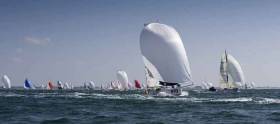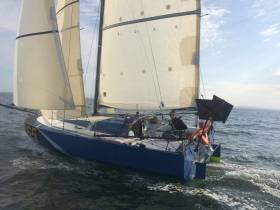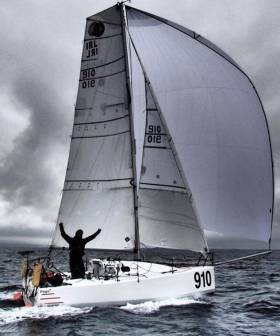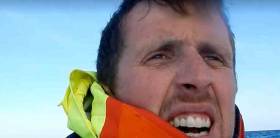Displaying items by tag: Tom Dolan
Less than two miles separate Ireland’s Tom Dolan in his Mini 650 Cellastab.com (IRL 910) from leader Benoit Hantzperg (Mahi-Mahi, 869) as they approach the western turning point in the Atlantic far beyond the Ile de Seine in the 220-mile Marie-Agnes Peron Trophy Race 2017 writes W M Nixon.
With 35 miles to sail to the finish over to the east at Douarnenez, they’re expected to be crossing the line in darkness around midnight, but the leaders are so closely packed that it’s anyone’s bet as to which ranking they’ll close with. Dolan has shuttled between 6th and 2nd as the race has progressed, however Hantzperg has been fairly constantly in the lead - albeit a very narrow one at times.
Winds at the moment are light to moderate from the southwest in the final leg in to the Baie de Douarnenez, and the chances of making anything other than infinitely small gains are very low if these conditions persist. But changing condition after dark may enable Dolan to improve on his current placing of fifth.
Tracker here:
Tom Dolan Has Good Night Racing in Bay of Biscay
Ireland’s Mini Transat campaigner Tom Dolan has moved up several places in a good night despite difficult racing in the Bay of Biscay in the 55-boat 220-mile Marie-Agnes Peron Trophy from Douarnenez writes W M Nixon.
Having had to contend with unstable nor’west winds to get past the Ile de Groix and on to the southerly turning point down towards Belle Ile, his Pogo 610 (IRL 910, sailing this race as Sellastab.com) was at one stage back in 9th in the 55 boat fleet, but overnight he moved up the rankings, and as of 0700 Irish time this morning was second in class with 98 miles still to race.
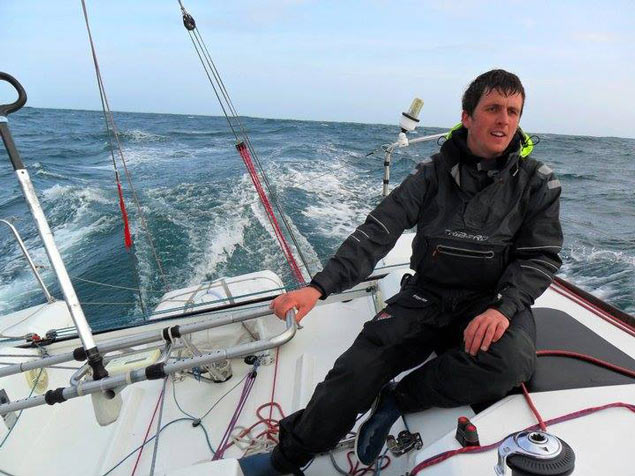 Ireland’s Tom Dolan has had a good showing in the overnight racing
Ireland’s Tom Dolan has had a good showing in the overnight racing
They are, however, 98 very challenging miles to sail as they take the fleet up past the Pointe de Penmarch and on out into open ocean to the westerly turning mark well beyond the Ile de Seine before they can head towards the finish in the Baie de Douarnenez.
Once again the leader on the water and heading the Proto division is Ian Lipinski’s remarkable Griffon. She’s perhaps the oddest-looking boat in the entire Mini fleet, but handsome is as handsome does.
Race tracker below:
Tom Dolan Lies Sixth in 220 Miles Sprint
Irish solo sailor Tom Dolan is back in contention tomorrow in France in the shortest race in the countdown to the Mini Transat in October writes W M Nixon. But although the Trophee MAP from Douarnenez south to Ile de Groix before returning outside Birvideaux Lighthous and the Chausee de Seine is “only” 220 miles long, Dolan is under double pressure as he is defending the title. Plus, as he wryly remarks, 220 miles is too short to allow any viable short-sleep pattern to develop - in fact, he may be awake throughout a race which involves some very tricky pilotage.
 A challenging course. With its varied navigational demands and occasional bursts of intense pilotage, the 220-mile Trophee MAP race which starts tomorrow in Douarnenez and finishes there within two days is “just long enough to get you exhausted but not long enough to develop a viable sleep-snatch pattern”.
A challenging course. With its varied navigational demands and occasional bursts of intense pilotage, the 220-mile Trophee MAP race which starts tomorrow in Douarnenez and finishes there within two days is “just long enough to get you exhausted but not long enough to develop a viable sleep-snatch pattern”.
Following his second overall (after leading for much of the race) in the 500-mile Mini-en-Mai which finished at La Trinite on May 12th, his supporters at home and in France have been beavering away to provide a more solid sponsorship support basis. It’s going the right way, so much so that today Tom’s Pogo 610 offshoresailing.fr (IRL 910) will have the Smurfit Kappa logo affixed to her mainsail.
Course tracker here:
Currently Dolan is third in the ranking in the hotly-contested class, as early season winner Pierre Chedeville (887) continues to lead, while Mini-en-Mai winner Erwan le Draoulec has moved into second. As for the race itself, with strong sou’westers forecast the fleet is under no illusions about the conditions they’ll face, with rough tough fast reaching needing constant attention. As Tom says: “It’ll be pockets stuffed with energy bars and a thermos filled with Barry’s strongest tea to see who can stay awake the longest”. Yet even in the midst of all his last-minute preparations for a rugged race, he still found the time to pass on his best wishes to fellow-Irish lone sailor Coner Fogerty, slugging into it out in the Atlantic in the OSTAR in his Sunfast 3600 Bam.
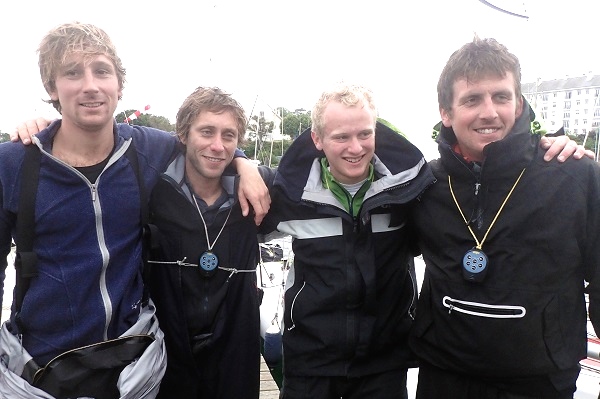 These MiniTransat skippers are a breed apart – this post-race group of four includes the three current top rankers: No 1 Pierre Chedeville (left), No 2 Erwan le Draoulec (second right), and No 3 Tom Dolan (right)
These MiniTransat skippers are a breed apart – this post-race group of four includes the three current top rankers: No 1 Pierre Chedeville (left), No 2 Erwan le Draoulec (second right), and No 3 Tom Dolan (right)
Ireland will be represented by County Meath sailor Tom Dolan in this year's Mini–transat, the race, that organisers say, remains, by far, the most international of single handed races. For the fortieth anniversary of the Mini Transat, there are no fewer than fourteen nationalities set to be represented at the start. In total, thirty racers from overseas will be competing, which equates to a little over a third of the overall line-up.
The fact remains that the Mini Transat, far from being a French preserve, has always attracted overseas applicants, far beyond the usual frontiers of solo offshore racing. Must it be repeated that from the second edition, it was a sailor from the US, Norton Smith, who dominated proceedings? Since the first edition of the Mini Transat, 13 overseas sailors have secured a podium finish. Our minds naturally turn to the Swiss sailors Laurent Bourgnon (2nd in 1987), Yvan Bourgnon (winner in 1995) and Bernard Stamm (3rd in 1995). We must add to this list the Polish sailor Kazimir Jaworski, 2nd in 1977 for the first edition of the race and New Zealander Chris Sayer, 3rd in 1999, aboard a prototype built in his native country. Certain overseas sailors have gone on to become stars of offshore racing, such as Britons Ellen MacArthur and Sam Davies. In Spain too, the Mini Transat has served as a springboard for sailors of the calibre of Alex Pella, winner of the Route du Rhum 2014 in Class40 as well as Anna Corbella, who is returning to the 2017 edition after completing two editions of the Barcelona World Race. In fact, the vitality of the Mini Class in southern Europe is evidenced by the fact that Italy and Spain make up the largest contingents of overseas sailors.
Below recent clips of Tom Dolan in action onboard 910:
This is the "Flying Irishman" Tom Dolan in France - he's currently training for the single-handed trans Atlantic Mini Transat race pic.twitter.com/TnmHRRUbud
— Irish Sailing (@Irish_Sailing) May 30, 2017
It really is one of the special features of the Mini Transat that it calls to sailors from right around the globe. All the way from the Antipodes, New Zealand and Australian sailors have come to do battle. Similarly, several Japanese and Chinese skippers have started out in the Mini, before returning to their home countries to spread the word about the wonders of the race. On the other side of the pond, the arrival destination is inevitably involved in the race too. In this way, for several editions now, we have seen entries from the West Indies. This year, Guadeloupe will be represented once again by Keni Piperol, at the helm of a prototype that was sailed by Italian sailor Michele Zambelli in 2015. Clearly, the Mini knows no bounds.
The nationalities taking the start in 2017
France – Estonia (1) – Switzerland (3) – Italy (7) – Ireland (1) – Belgium (1) – Spain (6) – Germany (4) – Holland (1) – Czech Republic (1) – Croatia (1) – Australia (1) – United Arab Emirates (1) – UK (1)
Tom Dolan Solo Video From 500-mile Mini-en-Mai Race
After Ireland’s Tom Dolan slipped to second in the 500-mile Mini-en-Mai in the last 30 miles last Friday he shared his frustration in a searingly honest analysis of his performance. Now he has put together a video (below) from race footage to give another unique insight into his race. He say's it's the 'full version' of what went on in the Mini en Mai 2017 and how, in his words, he 'made a hames of it'.
'I still haven't become much of a cameraman or filmaker and it's a bit of a long one but voila for those who want to see a bit what it's like during a race and the intense competition there is between us', he says. 'Sorry in the middle I switch a bit into Frenglish'. 'It was the fatigue', he concludes.
Keep up to date on Tom Dolan's progress towards this October's Mini Transat in Afloat.ie's dedicated solo sailing section here.
After Ireland’s Tom Dolan slipped to second in the 500-mile Mini-en-Mai in the last 30 miles on Friday, all of Irish sailing – and a wider community of supporters internationally – shared his frustration writes W M Nixon. But those of us who followed the Yellowbrick tracker all the way into port at La Trinite sur Mer after the finish very quickly spotted that Tom’s Pogo 3 Offshoresailing.fr (IR 910) had been lifted out into the marina-side boatyard.
Had something occurred to explain that loss of pace in the final stage? Seaweed jammed in the rudder perhaps? Or something small but significant picked up by the keel? No so. He had simply been very diligent in being one of the first to return the tracker to the race office. The boat was still afloat with no problems. In this searingly honest analysis, he tells us how it went pear-shaped:
“Winning races is a matter of making less mistakes than everyone else. There was no sea-weed on the keel or rudder, but a big big human error on my part, so I am a bit disappointed. Here's what happened:
As we passed north of Ile de Re on the last night I has a lead of 0.3 miles over Erwan le Draoulec racing the Pogo 3 Emile Henry (the distance is from the AIS, it's sort of like our television on board, we are always glued to it). During the last night I managed to pick up the lead to 0.8 miles, but we started to get headed. We both changed from the big to the medium kite and the distance was still stable at 0.8 miles. We continued to get headed while at the same time passing close to a headland with not a lot of water. I passed over 3 metres depth at 12 knots, and in my head I was trying to guesstimate the draft of the boat when heeled at 30°!
The wind increased to around 18 knots and after a couple of knock-downs, I changed to code 5. The change cost me 0.1 miles, but the distance stayed stable. Once we passed the headland, however, we bore off by 5 degrees and as Erwan had stayed under medium he started to catch me.
This was when I lost the race. It was a bit of a strange moment and it is a problem I have had before when very tired. I couldn't decide whether to change back to the medium or not. My brain just wouldn't make up its mind.
We had spent the entire night rock-hopping around Ile de Re to shelter from the tide, and as I had been in front I had done all the navigating. Erwan has simply followed me, and waited for his time to pounce. The distance decreased, 0.5, 0.4, 0.2 and when he was just to leeward of me, panic set in and I changed back to medium.
He was now 0.3 miles ahead and I cried (again, the fatigue can be very intense). Our coach tell us the there are times when you should not try to win a race, you should simply just not lose it. All I had to was wait on his backside, and wait for him to slip up. But no - with the frustration, disappointment and fatigue, and with my brain in crazy mode, I put the nail in the coffin.
I changed sail again to put up the big kite, and with the first gust I was screaming along at 13 knots, but at 30° to the route. Meanwhile Erwan stayed on course. The lateral separation increased bit by bit, and once we got headed, it was game over. The lateral will always have to be paid back at some stage.
Voila voile, that’s sailing, that was it. So I more or less gifted him the victory with two huge mistakes. All I had to do was stay between him and the mark and keep the same sail as him, and I would have won. But he was better on the day.
On the positive side I am very happy speed-wise, especially on vmg running. But I have a sort of a new nickname "vais pas trop vite!" – “Don’t go too fast!”. It’s a double-edged sort of thing, suggesting the other guys let me sprint away, and then wait to pounce.
By the end, I’d been fighting for that lead with maybe half a dozen other boats at different stages. Erwan was 1.6 miles ahead of me at the finish. But I in turn was four miles ahead of the next boat, Pierre Chedeville’s Pogo 3 Blue Orange Games, which at mid-race had been the boat with which I’d been most directly battling for first place.
We keep learning. And it’s really touching to arrive back and see all of the support from home. Sorry I made a bit of a hames of it at the end.
All the best,
Tom
Tom Dolan Finishes Second in Mini-en-Mai
The finish of the Mini-en-Mai at La Trinite sur Mer today concluded a period of frustration for Ireland’s Tom Dolan in Offshoresailing.fr, as he saw his wafer-thin class lead worn down by a succession of challengers in other Pogo 3s writes W M Nixon. The final and most successful of these was Erwan le Draoulec in Emile Henry, who started to show ahead in the final thirty miles.
The neck-and-neck pace for the lead which has dominated the race throughout saw other competitors fall astern as le Draoulec and Dolan speeded on their way. But try as he might, Dolan couldn’t manage to get in front again.
As they raced past the islands of Hoedic and Houat, le Draoulec got a final extra burst of speed which opened the gap, and his lead was reasonably secure the rest of the way to the finish, with his boat Emile Henry crossing the line at 15.48 local time. By this time he’d pulled out 1.6 miles on Dolan, who was across by 1600 hrs, all of four miles ahead of the next in line, Pierre Chedeville’s Blue Orange Games.
With two races now completed in the Mini 6.50 2017 series, Tom Dolan has a third and a second on the leaderboard, so it’s looking good for him overall. But for now, the thought is that for much of the race, he was looking for a win. All Irish sailing is with him.
Ireland’s Tom Dolan maintained a narrow lead during the third night of the 500–mile Mini-en-May with his Pogo 3 Offshoresailng.fr (IRL 910) as the fleet made their way through inshore passages past La Rochelle and inside the Ile de Re writes W M Nixon
The long haul from the southerly turn off Royan at the mouth of the Gironde Estuary northwest back to the finish at La Trinite sur Mer has been increasingly favoured by sou’west breezes, and as of
0750 Irish time this Friday morning, he was off St Gilles and making 9.9 knots with 66.2 miles to the finish, while closest rival Erwan Le Draoulec racing another Pogo 3, Emile Henry, was half a mile astern but every bit as fast.
Both have managed to shake off closest rival Pierre Chedeville in the Pogo 3 Blue Orange Games, who now has 73.2 miles to the finish. The leaders have a drag race in prospect for the final fifty miles, with every likelihood of a Friday daylight finish.
Three Leaders in Mini-en-Mai Neck-and-Neck at Royan Turn
Ireland’s Tom Dolan was neck-and-neck with Pierre Chedeville and Emile Henry as their three Pogo 3s closed in on the Royan turn at 1700hrs to lead their class in the 500-mile Mini-en-Mai offshore challenge, which leaves them with 147 miles still to race back to the finish at La Trinite sur Mer writes W M Nixon
With speeds around 6.5 knots in a southerly breeze which shows a tendency to veer, they’ve currently slightly less speed than the main body of the fleet astern. But with the turn made, it’s an entirely new ball game, with the course to be shaped towards the coast and some intriguing overnight pilotage which will take them close past La Rochelle and inside the Ile de Re.
The forecasts had been for a freshening south to southwest breeze, but the weather situation is fluid, and the increasingly coastal element to the course will see many other factors coming into play.

